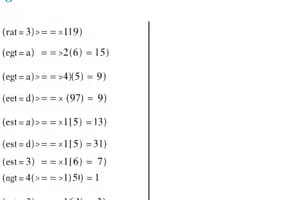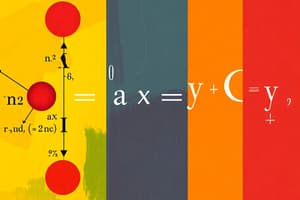Podcast
Questions and Answers
What does the matrix MR represent?
What does the matrix MR represent?
- A relation from set B to set A
- A relation from set A to set B (correct)
- A function of set A
- A relation between two different sets
Which of the following ordered pairs is included in the set R derived from matrix MR?
Which of the following ordered pairs is included in the set R derived from matrix MR?
- (a2, b1)
- (a1, b4) (correct)
- (a3, b2)
- (a2, b4)
What is the relationship between MR and MR−1?
What is the relationship between MR and MR−1?
- MR is the transpose of MR−1
- MR−1 is the transpose of MR (correct)
- MR is the inverse of MR−1
- MR and MR−1 are equal
In the context of a directed graph representation, what do the arrows represent?
In the context of a directed graph representation, what do the arrows represent?
Given the relation from A to B, how would you represent no relation from an element a1 to b2 in the matrix MR?
Given the relation from A to B, how would you represent no relation from an element a1 to b2 in the matrix MR?
How many elements would the digraph of relation R have based on the set A = {a1, a2, a3}?
How many elements would the digraph of relation R have based on the set A = {a1, a2, a3}?
What is the structure of MR if the relation contains no connections?
What is the structure of MR if the relation contains no connections?
What type of relation is represented if there are arrows going from one vertex to multiple vertices in a digraph?
What type of relation is represented if there are arrows going from one vertex to multiple vertices in a digraph?
What is the correct notation to denote that an element 'a' is part of set A?
What is the correct notation to denote that an element 'a' is part of set A?
How are sets denoted in mathematical notation?
How are sets denoted in mathematical notation?
In set theory, what is the significance of the order of elements in a set?
In set theory, what is the significance of the order of elements in a set?
Which notation is used to indicate that a certain condition is met by members of a set?
Which notation is used to indicate that a certain condition is met by members of a set?
Which of the following correctly represents a set of prime numbers less than 10?
Which of the following correctly represents a set of prime numbers less than 10?
What is the correct description of the symbols '∈' and '∉'?
What is the correct description of the symbols '∈' and '∉'?
In the context of set theory, what does the universal set refer to?
In the context of set theory, what does the universal set refer to?
What are the correct symbols for the set containing only the even numbers?
What are the correct symbols for the set containing only the even numbers?
What is the domain of the relation R defined from A = {1, 2, 3, 4} to B = {x, y, z}?
What is the domain of the relation R defined from A = {1, 2, 3, 4} to B = {x, y, z}?
What is the range of the relation R defined from A = {1, 2, 3, 4} to B = {x, y, z}?
What is the range of the relation R defined from A = {1, 2, 3, 4} to B = {x, y, z}?
How is the relation R represented in matrix form?
How is the relation R represented in matrix form?
What is the inverse relation R −1 of R, given R = {(1, y), (1, z), (3, y), (4, x), (4, z)}?
What is the inverse relation R −1 of R, given R = {(1, y), (1, z), (3, y), (4, x), (4, z)}?
Which of the following correctly describes the notation MR for a relation?
Which of the following correctly describes the notation MR for a relation?
If the matrix MR of a relation contains only 1s, what does this imply about the relation?
If the matrix MR of a relation contains only 1s, what does this imply about the relation?
Which of the following sequences is a solution to the recurrence relation $a_n = 8a_{n-1} - 16a_{n-2}$?
Which of the following sequences is a solution to the recurrence relation $a_n = 8a_{n-1} - 16a_{n-2}$?
What initial conditions would define the recurrence relation for deeper population growth in this model?
What initial conditions would define the recurrence relation for deeper population growth in this model?
How much will be in the account after 100 years with a 9% interest compounded annually on an initial deposit of $1000?
How much will be in the account after 100 years with a 9% interest compounded annually on an initial deposit of $1000?
What will be the world's population in 2050 if it is currently 6 billion and grows at a rate of 1.3% per year?
What will be the world's population in 2050 if it is currently 6 billion and grows at a rate of 1.3% per year?
Which of the following is not a characteristic of linear homogeneous recurrence relations?
Which of the following is not a characteristic of linear homogeneous recurrence relations?
What is the first term of the deeper population growth after one time period given the initial condition?
What is the first term of the deeper population growth after one time period given the initial condition?
For the growth rate derived from a 10% increase per time period, which equation describes the population at time n?
For the growth rate derived from a 10% increase per time period, which equation describes the population at time n?
Which expression correctly represents the amount in the account after n years with a principal $P$ at an interest rate $r$?
Which expression correctly represents the amount in the account after n years with a principal $P$ at an interest rate $r$?
Is the relation R = {(a, a), (b, b), (c, b), (d, d)} transitive?
Is the relation R = {(a, a), (b, b), (c, b), (d, d)} transitive?
Which of the following properties must hold true for a relation to be an equivalence relation?
Which of the following properties must hold true for a relation to be an equivalence relation?
What can be inferred if a relation R is reflexive and antisymmetric but not transitive?
What can be inferred if a relation R is reflexive and antisymmetric but not transitive?
Given the relation R = {(a, a), (b, c), (c, b), (d, d)}, is R transitive?
Given the relation R = {(a, a), (b, c), (c, b), (d, d)}, is R transitive?
In the set {1, 2, 3, 4}, which relation can be reflexive, symmetric, and not transitive?
In the set {1, 2, 3, 4}, which relation can be reflexive, symmetric, and not transitive?
Which task must necessarily be completed before turning on the flash unit?
Which task must necessarily be completed before turning on the flash unit?
For the relation R = {(a, a), (b, b), (c, b), (d, d)}, which property does it not satisfy?
For the relation R = {(a, a), (b, b), (c, b), (d, d)}, which property does it not satisfy?
What characteristic is not required for a partial order?
What characteristic is not required for a partial order?
Study Notes
Expected Learning Outcomes
- Ability to explain, solve and apply logical relationships.
- Competence in using sets and relations to solve problems.
- Familiarity with properties of numbers, relations, and functions in problem-solving.
- Understanding and applying inclusion and exclusion principles.
- Skills to resolve problems related to elementary graph theory.
Set Theory
- A set is a well-defined collection of objects or numbers, denoted by uppercase letters.
- Elements of a set are denoted by lowercase letters, represented in curly brackets (e.g., A = {a, b, c}).
- Membership of an element in a set is indicated using ∈ (e.g., a ∈ A) or ∉ (e.g., x ∉ A).
Specifying a Set
- List Notation: Members are listed in curly brackets (e.g., C = {Kshs, USD, Euro, Pound}). Order of elements is irrelevant.
- Predicate Notation: Specifies sets based on shared conditions, useful when complete membership is unknown.
Representation of Relations
- Relations between two sets A and B can be expressed using a matrix, where the entry is 1 if an ordered pair belongs to the relation and 0 if not.
- For sets A and B, the matrix ( M_R ) is an ( m \times n ) grid where ( m ) and ( n ) are the number of elements in sets A and B, respectively.
Matrix Representation Example
- Given A = {1, 2, 3} and B = {r, s}, the relation R defined by ( R = {(1, r), (2, s), (3, r)} ) has the matrix representation: [ M_R = \begin{pmatrix} 1 & 0 \ 0 & 1 \ 1 & 0 \end{pmatrix} ]
Undirected Graph Representation
- Relations can be depicted as directed graphs (digraphs) by drawing circles for each element and using arrows to show connections based on the relation.
Transitive Relations
- A relation is transitive if whenever it contains pairs (a, b) and (b, c), it must also contain (a, c).
- Examples provided to discern transitive properties in relations.
Equivalence Relations
- An equivalence relation is reflexive (every element relates to itself), symmetric (if a relates to b, then b relates to a), and transitive.
- A partial order is reflexive, antisymmetric (if a relates to b and b relates to a, then a must be equal to b), and transitive.
Exercises
- Tasks include providing specific examples of relations based on defined properties (reflexive, symmetric, transitive) and interpreting digraphs.
Linear Homogeneous Recurrence Relation
- Defined as ( a_n = c_1 a_{n-1} + c_2 a_{n-2} + \ldots + c_k a_{n-k} ) for constants ( c_i ).
- Examples illustrate how to formulate a recurrence relation based on a given scenario, such as population change over time.
Applications of Recurrence Relations
- Practice problems set for tasks such as population growth, interest accumulation, and scheduling, demonstrating real-world scenarios where recurrence relations apply.
- Example of population growth initiates with a given amount and growth percentage, establishing foundational computational methods.
Studying That Suits You
Use AI to generate personalized quizzes and flashcards to suit your learning preferences.
Related Documents
Description
Explore key concepts and applications in Discrete Mathematics with these comprehensive lecture notes. Learn about logical relationships, sets, relations, and properties of numbers essential for problem-solving in the field. Perfect for students aiming to deepen their understanding of discrete structures and their practical applications.




